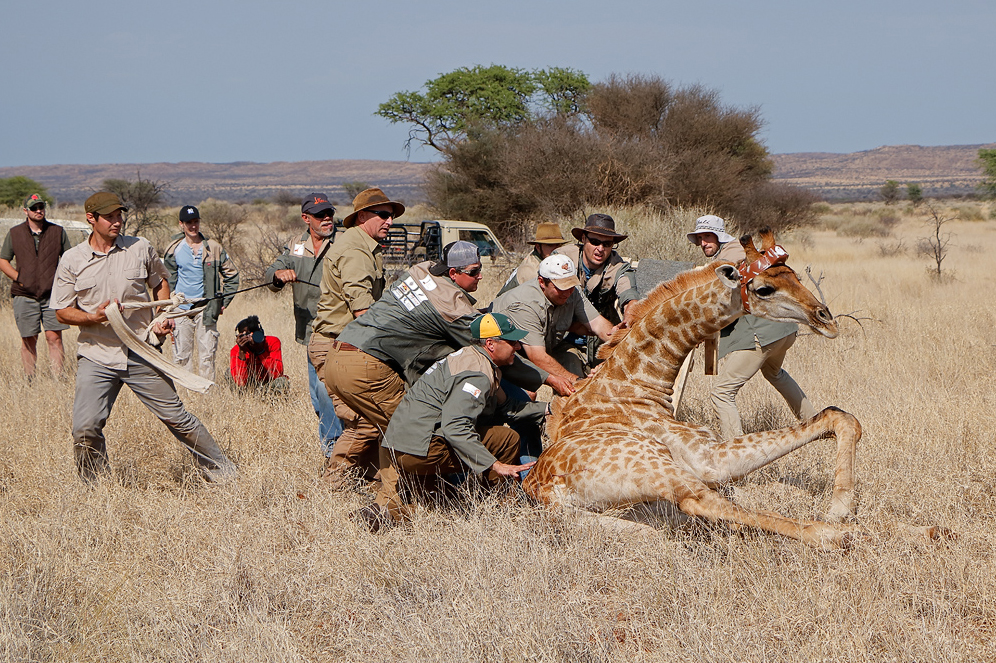21 December 2020
|
Story Andre Damons
|
Photo Supplied
 The research team helps a giraffe to get up after they have finished collecting data.
The research team helps a giraffe to get up after they have finished collecting data.
Researchers from the University of the Free State (UFS) hope their research to investigate why some animals prefer or avoid some habitats, will also create awareness for the plight of giraffes which have lost more than 80% of some of their subspecies in East Africa and are facing extinction in the wild.
Dr Marietjie Schutte-Smith, Senior Lecturer in the Department of Chemistry, says the collaborative research being done in South Africa is very unique and could help save subspecies from the brink of extinction – as South Africa has managed to double its giraffe numbers whilst subspecies have declined tremendously.
Why some animals prefer or avoid some habitats
“By using modern analysis techniques and instruments (such as drones and GPS devices), it is possible to study complex environments on a spatial ecology scale and has created the opportunity to investigate why some animals prefer or avoid some habitats,” explains wildlife expert Dr Francois Deacon.
“This in turn opened the door to explore geographic, soil and nutritional qualities the giraffe might prefer or avoid. This is one of the main reasons we are exploring the different factors and driving forces behind a large herbivore’s habitat selection, well-being, body condition parameters and physiological adaptations,” Dr Deacon says.
Veld conditions, plant species composition, tree densities and other available resources such as production yield and water quality determine reproduction successes and how animals disperse, move and distribute over an area. Spatial and ecological distributions of giraffe specifically depend on habitat resources and qualities that in turn affect their complex behavioral tactics and survival.
Strange habits
The research was started back in 2010 by Dr Deacon and Prof Nico Smit from the Department of Animal, Wildlife and Grassland Sciences at the UFS with the pioneering of GPS devices to investigate giraffe spatial ecology and habitat use. The current study was initiated as to why the giraffe would utilise one area more than the other, even if the two habitats had the same tree species, says Dr Schutte-Smith.
Dr Deacon contacted Prof Hendrik Visser and Dr Schutte-Smith from the Department of Chemistry for a possible collaborative effort. Ms Jeaneme Kuhn started her MSc research degree on this project in January 2019 and completed her degree in August 2020 with distinction.
Dr Schutte-Smith says from research done at Rooipoort Nature Reserve it was found that a certain group of giraffes had the strange habit of only eating from specific trees, avoiding similar trees a few metres away. “We wanted to see if this behaviour was due to chemical influences, i.e. if there are specific minerals that are possibly in excess at some places which they avoid, especially since there are mines close by.”
Aim of the research
The main aim of this MSc Chemistry degree, according to Dr Schutte-Smith, is to validate an analytical method for testing leaves and soil samples, using IPC, to see if heavy metals (in excess) are present in the soil, leaves and water and whether this has an influence on the browsing pattern of the giraffes. “Then as secondary aims (for the collaborative effort) we would like to investigate if the giraffe can select one area above the other (core home ranges), to understand what the qualities are that they would select for in the preferred area and what the qualities they avoid are in the other. And lastly to understand what the minimum requirements are to keep the animals happy and healthy, but also to investigate how they search for these qualities,” says Dr Schutte-Smith.
Giraffe conservation
Besides creating awareness of the plight of giraffes, the researchers also aim to create a model for conservation via research and education to be used as an example for other countries. This model incorporates students, academia, professionals, sponsors and stakeholders that cover various topics relating to giraffe education, management and conservation.
They would also like to see the UFS as the institution that has contributed the most to giraffe conservation strategies in Africa by being the leading university in the collection and analysis of information about giraffes and their habitats, increasing conservation education awareness about giraffes and African biodiversity and to develop national and/or regional plans aimed at giraffe conservation.
The research team successfully applied for funding which they used for chemicals and solvents to perform testing as well as sampling.